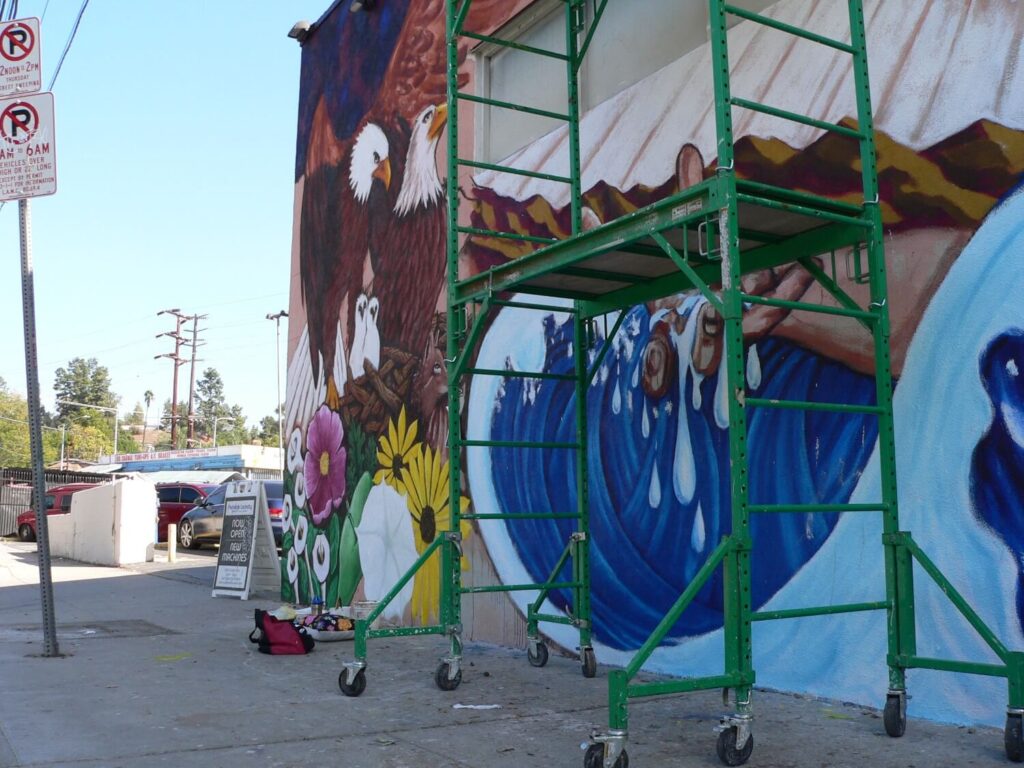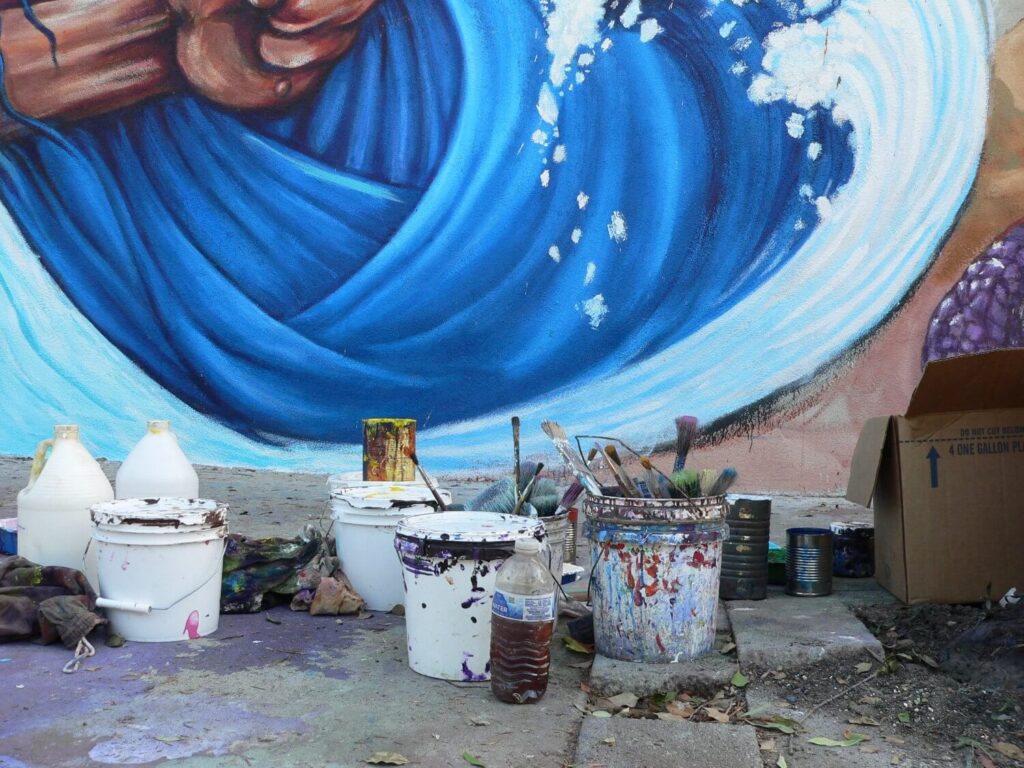
“Water is Life, there is no alternative,” reads Arroyo Arts Collective‘s description of Joe Bravo‘s new mural-in-progress in Highland Park.
Bravo, a Highland Park-based artist best known for making art on tortillas, said he hopes to visualize California’s ongoing water crisis by making a mural visible to the public. According to his website, Bravo found his love for art while growing up in Calexico, California making figurines with mud and swords with scrap wood. Although he is now retired, Bravo continues to use artwork like “Water is Life” to uplift his community.
The project is sponsored by Avenue 50 Studio and LA Council District 14.
According to Bravo, this project has been a community effort from the start. He said there were several community meetings where local residents could give their input on the project; additionally, students from Burbank Middle School and art interns from Rock Rose Gallery helped paint the mural, which is located on the wall of Parkside Laundry.
“I want it to be total community involvement,” Bravo said. “It was a good experience to see different aspects [of] the community [members] who wanted to participate.”

Antonio Castillo, a Highland Park resident and board member of the Highland Park Preservation Trust, said he was excited that Bravo is creating a space for community involvement.
“I’ve really enjoyed it since I heard Mr. Bravo’s concept,” Castillo said. “And then bringing in the community to provide some input, I thought that was just amazing.”
Rock Rose Gallery opened up on Figueroa Street in 2000 and focuses on art and community building. Owner Rosamaria Marquez established an arts internship program with Academia Avance and Highland Park High School.
“I can’t tell you how happy I am that we’re involved with [Bravo],” Marquez said. “He welcomes us, and [the interns] get that wonderful experience. He’s very patient, he trains [them] and they will only get stronger.”
Bravo said that since he started painting the mural in early September, he has worked from 10 a.m. to 2 p.m. Monday through Friday. By making the painting process public and bringing on collaborators, he furthers his interaction with the community.

According to the mural’s mission statement, “Water is Life” represents the stewardship and management of Northeast LA’s (NELA’s) water resources.
“It’s a historical mural of the usage of water in this part of Los Angeles — how we’ve used it [and] how it started off where it could support the indigenous population that was here,” Bravo said. “I mean, everybody knows we’re in a water crisis, but I was trying to visualize it for everybody in my own way.”
Bravo said he has sought to represent the theme of “Water is Life” by researching the history of water in NELA, getting input from community members and including native imagery on the mural.
Toypurina, an Indigenous medicine practitioner famous for leading a revolt against the San Gabriel Mission, is at the center of the mural. Bravo depicts her as a metaphor for the Sierra Madre mountains in how she provides life for the inhabitants of the area. She holds one hand outstretched, nourishing the land with seeds. With the other hand, Bravo said, she is offering water.
“She’s a metaphor for all the [Sierra Madre] Mountains offering us all this water, but she’s doing it with love,” he said, referencing the convergence of the waves in the mural to form a heart.
“Water is Life” includes other symbols native to this land, such as prickly pears, the Big Bear bald eagles and the famous neighborhood cougar P-22. While maintaining the mural’s focus on water, Bravo highlights the history and relevance of Indigeneity in NELA.
“We used to supply the water, but now we’re importing water,” Bravo said. “So I don’t know how much longer we can sustain this.”
Bravo said he hopes the positive symbolism and public accessibility of the mural can uplift the Highland Park community, while also directing focus to the ongoing water crisis.
“[The location] is perfect because it’s right across from the park,” Bravo said. “Murals are usually on a busy street, or they’re really inaccessible to the viewing public, but here, people can come sit down, have a barbecue and enjoy the artwork. So hopefully it will uplift the community.”

Castillo said that the public nature of “Water is Life” demands a different kind of appreciation from other areas of the artistic industry.
“It’s part of the community’s fabric,” Castillo said. “It gives it its color, it gives it its ambiance, as opposed to keeping it to yourself somewhere.”
To Castillo, the way Bravo incorporated the community makes all the difference.
“One thing that I appreciate from an artist is for them to foster the communication to result in a product, a mural in this case,” Castillo said. “What I enjoyed about this process is that from the beginning, it’s like, ‘What do you guys envision? What do you guys want? What represents your community?’ And this is a result of people’s input and people’s ideas.”
Marquez said that what Bravo is doing is incredible.
“And everybody has their turn at doing something significant in a community,” Marquez said. “As small as we are, we work together. I love that about Highland Park.”
According to Castillo, the Highland Park Heritage Trust aims to preserve and tell stories about the community for future generations. He said that the power usually comes from residents who are active in their communities.
“We’ve seen the community change over the years,” Castillo said. “I stay active as much as possible, and I try to contribute as much as possible.”
For Bravo, painting murals helps brighten up the concrete community.
“I’m just trying to do my part,” Bravo said.
While there is no set date for the mural’s completion, Bravo said he would be happy if “Water is Life” can be finished before the end of the year.
![]()


































